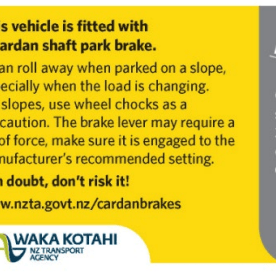
NZ Police commercial vehicle safety teams (CVST) are employing a new generation of mobile roller brake testers and thermal imaging devices (TIDs) with the aim of improving road safety and reducing the potential of poor heavy vehicle brake performance being a contributing factor in serious injury or deaths.
Beginning in June, CVST will be able to identify potential brake performance issues more easily anytime, due to the introduction of new brake safety monitoring technology.
Six new BM20200 mobile roller brake testers (MRBTs) are being rolled out nationwide to CVST as well as handheld thermal imaging devices to each CVST vehicle and each of the six weigh stations.
The MRBTs (also known as roller brake test machines) are equipped with the same electronics and software as the fixed inground roller brake machines that Waka Kotahi NZ Transport Agency will be installing in commercial vehicle safety centres (CVSC) as a part of its Weigh Right Programme.
Police have been working with Waka Kotahi to ensure the MRBTs being rolled out align with the fixed inground roller brake machines performance, which should enable high comparability in both testing and data processing.
The CVST investment complements the Weigh Right Programme, which is to increase compliance, improve road safety, and create a level playing field for all commercial operators.
According to NZ Police publicity, the MRBTs enable roadside brake tests to be carried out easily and effectively for all vehicles up to a maximum axle load of 20,000kg. They can be placed on an asphalt or concrete floor, as well as on an uneven gravel ground, such as sand and dirt. So obviously, there is a significant benefit in that there are no particular requirements to the testing area surface meaning CVST could undertake a brake test anytime, anywhere.
The new MRBTs have a set height of only 160 mm, which ensures against bottoming out when very low vehicles are subjected to testing. Due to the low height of the roller set, the length of the ramps is a relatively short 1.25 metres on each side, so a total setup length of only 3.5 metres.
Police are also distributing 84 handheld TIDs, one to each CVST vehicle and one for each of the six weigh stations.
The TIDs will help assess a vehicle’s braking fitness without the need for a physical inspection.
A TID displays the temperature of the brake drum or disk on each wheel. If the thermal image shows a drum or disk with a different temperature compared to others on the vehicle, it may be indicative of an issue with the brakes which would trigger the need for a further investigation.
Police expect the brake screening process using the new TDIs to be reliable enough to assist CVST correctly target the unsafe vehicles with their limited resources.
However, RTF accepts the CVST can stop a vehicle for inspection anytime, anywhere.




